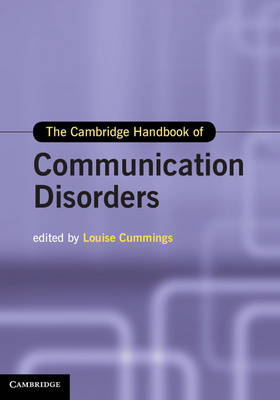
The Cambridge Handbook of Communication Disorders
Cambridge University Press (Verlag)
978-1-107-02123-5 (ISBN)
Many children and adults experience impairment of their communication skills. These communication disorders impact adversely on all aspects of these individuals' lives. In thirty dedicated chapters, The Cambridge Handbook of Communication Disorders examines the full range of developmental and acquired communication disorders and provides the most up-to-date and comprehensive guide to the epidemiology, aetiology and clinical features of these disorders. The volume also examines how these disorders are assessed and treated by speech and language therapists and addresses recent theoretical developments in the field. The handbook goes beyond well-known communication disorders to include populations such as children with emotional disturbance, adults with non-Alzheimer dementias and people with personality disorders. Each chapter describes in accessible terms the most recent thinking and research in communication disorders. The volume is an ideal guide for academic researchers, graduate students and professionals in speech and language therapy.
Louise Cummings is Professor of Linguistics at Nottingham Trent University. She is a member of the Royal College of Speech and Language Therapists and is registered with the Health Professions Council in the UK.
Part I. Developmental Communication Disorders: 1. Cleft lip and palate and other craniofacial anomalies John E. Riski; 2. Developmental dysarthria Megan Hodge; 3. Developmental verbal dyspraxia Brigid McNeill; 4. Developmental phonological disorder Susan Rvachew; 5. Specific language impairment Susan Ellis Weismer; 6. Developmental dyslexia Catherine Christo; 7. Intellectual disability and communication Katherine Short-Meyerson and Glenis Benson; 8. Emotional disturbance and communication Gregory J. Benner and J. Ron Nelson; 9. Autistic spectrum disorders and communication Courtenay Frazier Norbury; Part II. Acquired Communication Disorders: 10. Head and neck cancer and communication Tim Bressmann; 11. Acquired dysarthria Bruce E. Murdoch; 12. Apraxia of speech Donald A. Robin and Sabina Flagmeier; 13. Aphasia Roelien Bastiaanse and Ronald S. Prins; 14. Right hemisphere damage and communication Yves Joanette, Perrine Ferré and Maximiliano A. Wilson; 15. Dementia and communication Jamie Reilly and Jinyi Hung; 16. Traumatic brain injury and communication Leanne Togher; 17. Psychiatric disorders and communication Karen Bryan; Part III. Voice, Fluency and Hearing Disorders: 18. Functional and organic voice disorders Nadine P. Connor and Diane M. Bless; 19. Stuttering and cluttering Kathleen Scaler Scott; 20. Hearing disorders R. Steven Ackley; Part IV. Management of Communication Disorders: 21. Developmental motor speech disorders Kirrie Ballard and Patricia McCabe; 22. Acquired motor speech disorders Anja Lowitt; 23. Developmental language disorders Laurence B. Leonard; 24. Acquired aphasia Anne Whitworth, Janet Webster and Julie Morris; 25. Disorders of voice Linda Rammage; 26. Disorders of fluency J. Scott Yaruss; Part V. Theoretical Developments in Communication Disorders: 27. Motor speech disorders and models of speech production Karen Croot; 28. Adult neurological disorders and semantic models Tobias Bormann; 29. Language in genetic syndromes and cognitive modularity Vesna Stojanovik; 30. Pragmatic disorders and theory of mind Louise Cummings.
| Reihe/Serie | Cambridge Handbooks in Language and Linguistics |
|---|---|
| Zusatzinfo | 18 Tables, black and white; 38 Halftones, unspecified; 16 Line drawings, unspecified |
| Verlagsort | Cambridge |
| Sprache | englisch |
| Maße | 182 x 253 mm |
| Gewicht | 1570 g |
| Themenwelt | Geisteswissenschaften ► Psychologie ► Entwicklungspsychologie |
| Geisteswissenschaften ► Sprach- / Literaturwissenschaft ► Sprachwissenschaft | |
| Medizin / Pharmazie ► Gesundheitsfachberufe ► Logopädie | |
| ISBN-10 | 1-107-02123-5 / 1107021235 |
| ISBN-13 | 978-1-107-02123-5 / 9781107021235 |
| Zustand | Neuware |
| Haben Sie eine Frage zum Produkt? |
aus dem Bereich


